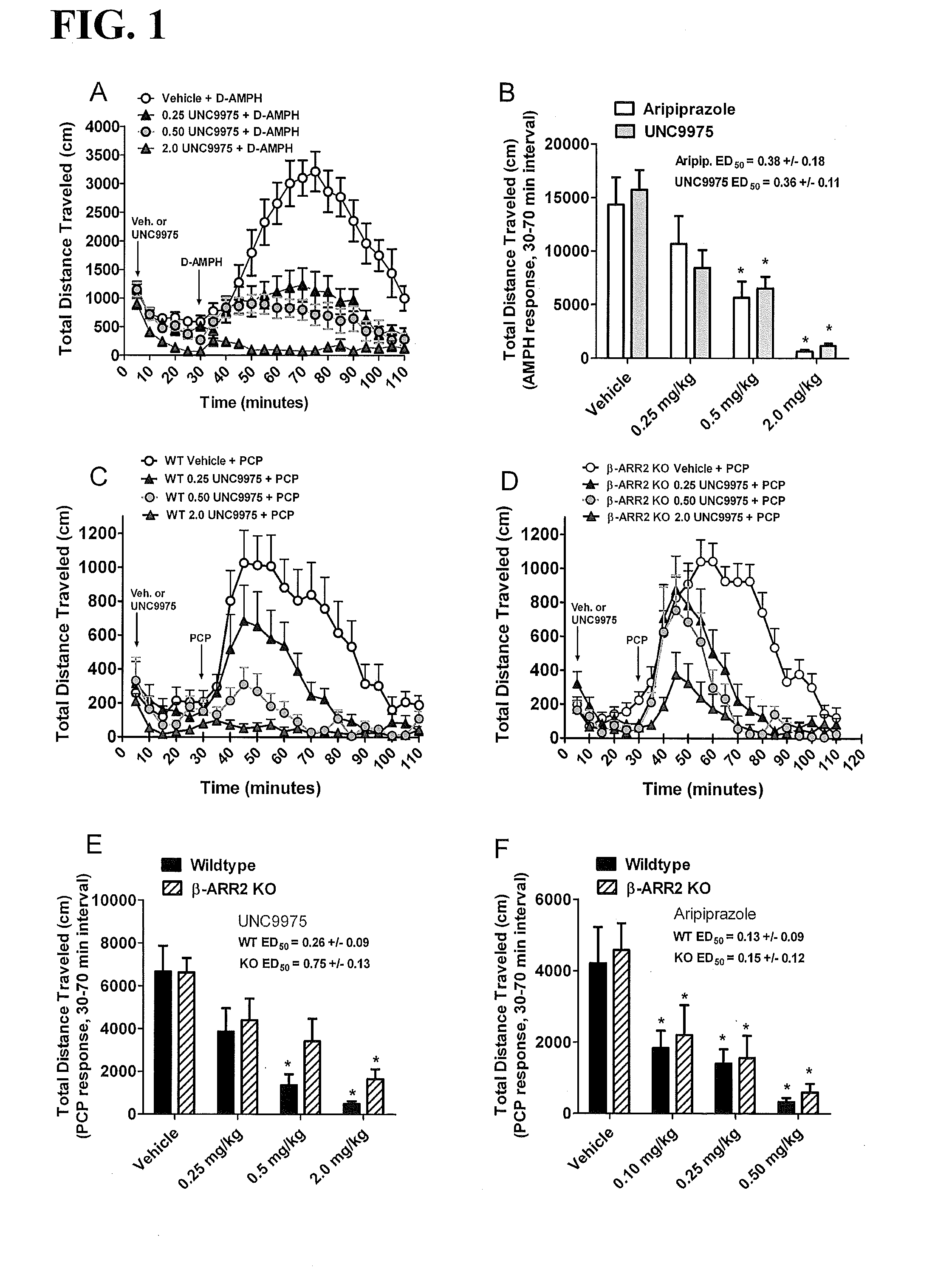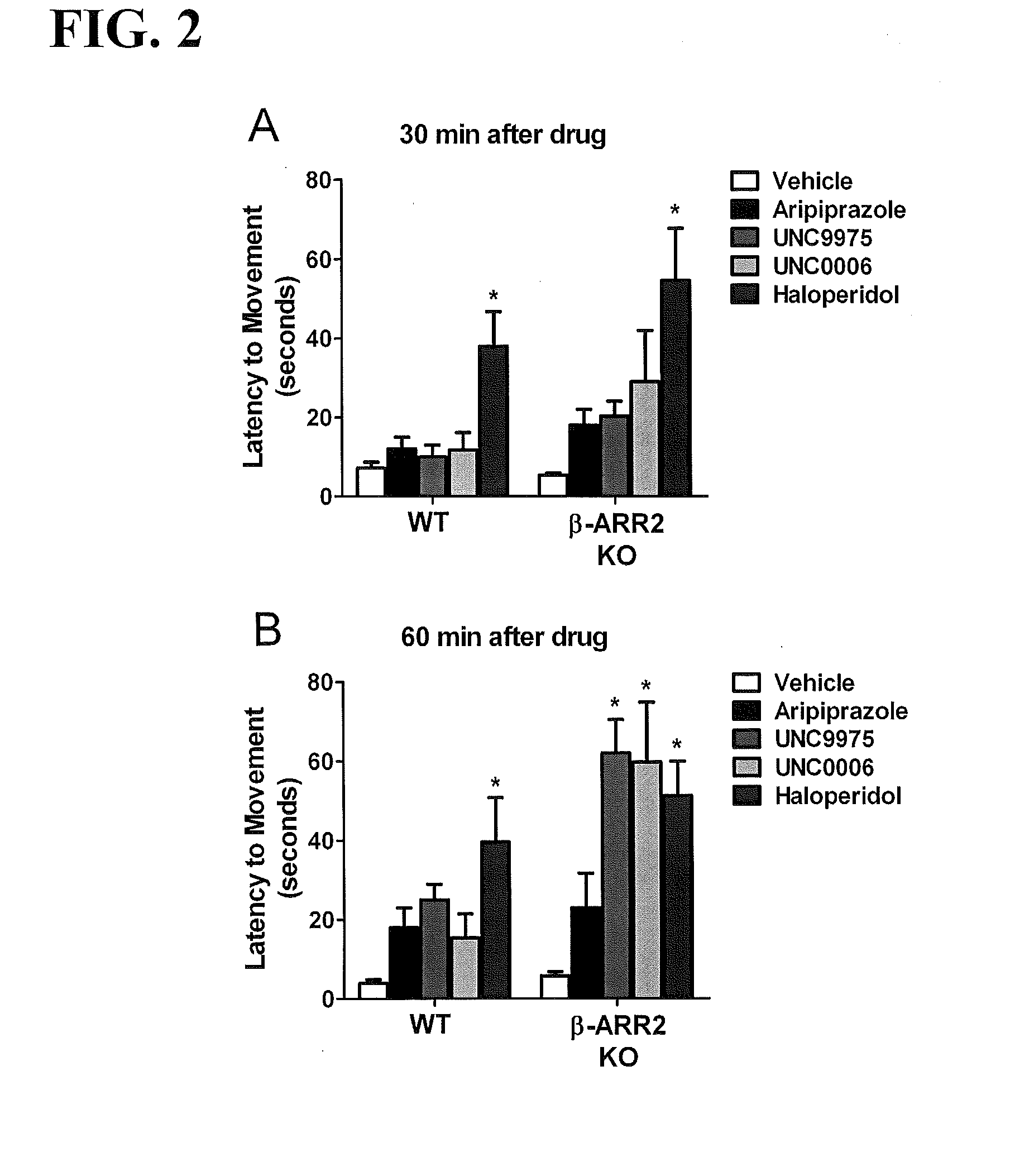Novel Functionally Selective Ligands of Dopamine D2 Receptors
- Summary
- Abstract
- Description
- Claims
- Application Information
AI Technical Summary
Benefits of technology
Problems solved by technology
Method used
Image
Examples
example 1
Synthesis of Compounds
[0169]The compounds shown in Table 5 were synthesized as described below.
TABLE 5Compound NumberStructureName 17-(3-(4-(2,3-dichlorophenyl)-1,4-diazepan-1- yl)propoxy)-3,4-dihydroquinolin-2(1H)-one (UNC10000003A) 27-(4-(4-(2,3-dichlorophenyl)-1,4-diazepan-1- yl)butoxy)-3,4-dihydroquinolin-2(1H)-one (UNC10000006A, or UNC0006) 37-(4-(4-(2,3-dichlorophenyl)-1,4-diazepan-1- yl)butoxy)-3,4-dihydro-1,8-naphthyridin- 2(1H)-one (UNC10099975A, or UNC9975) 47-(4-(4-(2,3-dichlorophenyl)-1,4-diazepan-1- yl)butoxy)quinolin-2(1H)-one (UNC10099978A) 57-(3-(4-(2,3-dichlorophenyl)-1,4-diazepan-1- yl)propoxy)-3,4-dihydroisoquinolin-1(2H)- one (UNC10099983A) 67-(4-(4-(2,3-dichlorophenyl)-1,4-diazepan-1- yl)butoxy)-3,4-dihydroisoquinolin-1(2H)-one (UNC10099984A) 75-(4-(4-(2,3-dichlorophenyl)-1,4-diazepan-1- yl)butoxy)benzo[d]thiazole (UNC10099992A) 85-(3-(4-(2,3-dichlorophenyl)-1,4-diazepan-1- yl)propoxy)benzo[d]thiazole (UNC10099996A) 97-(4-(4-(2-methoxyphenyl)-1,4-diazepan-1-yl)...
example 2
In Vitro Studies
[0337]Each of the synthesized compounds were tested in a variety of in vitro assays for D2 receptor activity. Results are summarized in Table 6.
[0338]CHO-D2 Membrane Preparation for GTP-Radioligand Binding Assays
[0339]Cells stably expressing D2 receptors (CHO-D2) were plated in 15-cm dishes (in DMEM containing 10% fetal bovine serum and grown to 90% confluence. Then, cells were washed with PBS, pH 7.4, and harvested by scraping into PBS, pH 7.4. Harvested cells were centrifuged at 1,000×g for 10 min, then hypotonically lysed by resuspension in ice-cold 50 mM HEPES, 1% BSA, pH 7.4. Membranes were isolated by centrifugation at 21,000×g for 20 min. The supernatant was removed and the membrane pellets were assayed for D2 ligand-stimulated GTP-gamma-S binding or stored at −80° C. until used for radioligand binding assays.
[0340]CHO-D2 Radioligand Binding Assay
[0341]Membranes prepared as above were resuspended to 1 μg protein / μl (measured by Bradford assay using BSA as stan...
example 3
In Vivo Studies
[0355]Compounds 2 (UNC10000006A, or UNC0006) and 3 (UNC10099975A, or UNC9975) were evaluated in D-amphetamine-induced hyperlocomotion, phencyclidine (PCP)-induced hyperlocomotion, and / or catalepsy mouse models.
[0356]Mice. All experiments were approved by the Institutional Animal Care and Use Committees at the University of North Carolina, Chapel Hill and Duke University. C57BL / 6J and β-arrestin-2 knockout (Bohn et al., Science 286:2495 (1999)) mice were housed under standard conditions—12 hour light / dark cycle and food and water provided ad libitum. Adult, age-matched male and female C57BL / 6J and β-arrestin-2 knockout drug naive mice were used for all behavioral testing.
[0357]Locomotor activity. Mouse locomotor activity was assessed in photocell-based activity chambers under standardized environmental conditions, using an AccuScan activity monitor (AccuScan Instruments, Columbus, Ohio) with a 25.8×25.8 cm Plexiglas chamber and a beam spacing of 1.52 cm as described (A...
PUM
| Property | Measurement | Unit |
|---|---|---|
| Volume | aaaaa | aaaaa |
| Volume | aaaaa | aaaaa |
| Volume | aaaaa | aaaaa |
Abstract
Description
Claims
Application Information
 Login to View More
Login to View More - R&D
- Intellectual Property
- Life Sciences
- Materials
- Tech Scout
- Unparalleled Data Quality
- Higher Quality Content
- 60% Fewer Hallucinations
Browse by: Latest US Patents, China's latest patents, Technical Efficacy Thesaurus, Application Domain, Technology Topic, Popular Technical Reports.
© 2025 PatSnap. All rights reserved.Legal|Privacy policy|Modern Slavery Act Transparency Statement|Sitemap|About US| Contact US: help@patsnap.com



